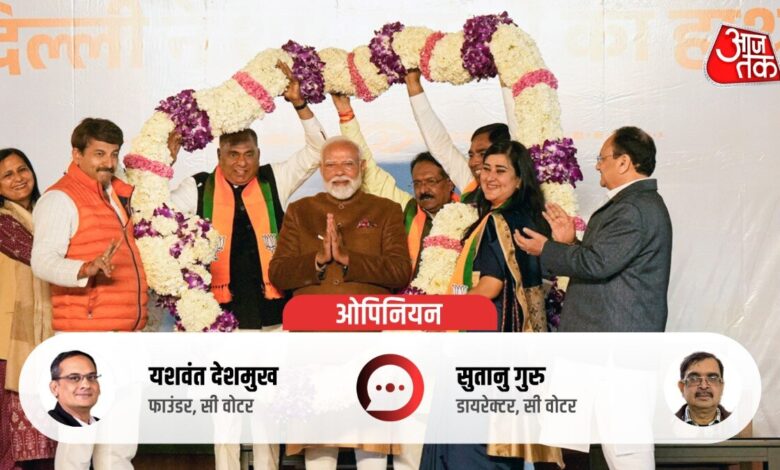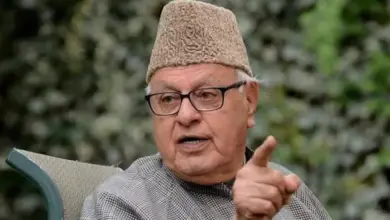Delhi’s election is the ‘masterclass’ of team Modi’s strategy … Such victory in the capital – Delhi Assembly Elections A MasterClass in Strategy by TEAM MODI NTCPAN

Any election is like an interesting battle in politics. As the Delhi Assembly elections have once again shown that the best way to fight and win the battle is to create a concrete strategy and apply it with accuracy and efficiency in the battlefield. Once again, the Bharatiya Janata Party has indicated that when it comes to implementing a concrete strategy, there is no BJP contest in the Narendra Modi era.
Since 1998, the ‘Delhi is a serious warning for the party. Even during the election Mahasamar being run by Amit Shah, the election victory in Delhi remained an elusive dream for the BJP, as the Aam Aadmi Party led by Arvind Kejriwal was continuously registering a spectacular victory here.
Target of 15% increase in vote share
The BJP was confused after continuously suffering the election defeat. Because in the Lok Sabha elections, about 55 percent of the voters of Delhi chose BJP. But when it comes to assembly elections, more than 15 percent of this group goes towards AAP. This dilemma became the basis of BJP’s strategy and BJP got involved in persuading this 15 percent vote to remain with the party. In another way, the strategy was straightforward that the AAP vote share was reduced by about 10 percent and the BJP’s vote share in this proportion.
No one can have a solid strategy on paper. For example, the Congress strategy was to get a double digit vote share to remain politically relevant in Delhi. The AAP strategy to ensure 54 percent of the vote share (as in 2015 and 2020) retained to a great extent. Still both failed even though BJP’s strategy in Delhi came in handy as magic. Some people refuse to give credit to the strategy of other leaders along with Modi-Shah. But from 2014, the victory in many elections across the country will force political parties to advise to follow the strategy adopted by the BJP for any fair commentator.
In the 2024 Lok Sabha elections, the voters alerted the BJP by giving less seats and how the story changed in less than a year. Since then, BJP has won three impossible victories including Haryana, Maharashtra and now Delhi. At the same time, the defeat in Jharkhand has reminded the BJP that no person or organization is infallible.
BJP has increased steps one by one
A successful strategy requires some things. Such as a disciplined and committed group of adequate financial resources, soldiers, generals and staff officers to be used at the right time, using and deployment of amazing weapons during the war being at the peak. Most importantly, the ability to replace the strategy immediately.
Also read: Regional equation, ethnic mathematics or new face … These factor will decide BJP’s next Chief Minister in Delhi
All these factors worked well in the Delhi assembly elections. The availability of financial resources has not been a challenge for the BJP for a long time. If needed, it has enough money to spend more than any opponent. But as the BJP has shown some failures in the elections, especially during the 2024 Lok Sabha elections, spending a lot of money to win the election is not enough.
Played associate organizations
The second important element of successful strategy is the ability to deploy committed soldiers. This is an area where no other party can match the BJP’s ability to use the resources and manpower of the Sangh Parivar. In the preparation of the 2024 Lok Sabha campaign, the days filled with ego have gone long ago. When party president JP Nadda unknowingly gave the notion that this BJP, which is ready for the future, could not need the RSS cadre.
In Haryana, Maharashtra and now Delhi, Narendra Modi personally ensured that angry workers come back to the streets, knock doors, go to booths and spread the message quietly while maintaining confidence. In this campaign of Delhi, it seems that RSS workers have organized more than 50 thousand dialogues with small groups. All other organizations of the Sangh Parivar, including the Akhil Bharatiya Vidyarthi Parishad, Bajrang Dal, Indian Mazdoor Union and others, were tasked to keep the focus on their target group.
Also read: 10 years of AAP in Delhi: Kejriwal’s decisions that faded brand AK shine
To ensure that the organization does not wander its purpose, the BJP, like a well -prepared team, deployed staff officials to take its leaders to already decided areas. People operating an organization like Bajrang Dal knew where the presence and rhetoric of this organization would work and where it could be reversed. BMS members were deployed in areas filled with factories and other laborers, which became a staunch supporter of Arvind Kejriwal.
Rales of big leaders of BJP
Similarly, at least at least a dozen senior BJP leaders were actively campaigning in Delhi, leading the processions, organizing rallies and addressing many meetings. Due to Delhi being a city, this work became easy for the BJP. During the campaign, big BJP leaders of UP, Bihar, West Bengal, Assam, Telangana, Tamil Nadu and Odisha were campaigning in different areas. A very important element of successful strategy is the agility with which the top officers of the army can change the strategy between the fierce war. Similarly, during the initial phase of the campaign, the BJP’s attention was on corruption charges against Arvind Kejriwal and his alleged ‘Sheesh Mahal’ and became the main focus of the party.
Shifted focus from ‘Sheesh Mahal’
But in the beginning of January, internal feedback started coming from survey and booth level workers that allegations of corruption have failed to influence lower class and poor voters who remain committed and loyal to AAP. The feedback was clear that the BJP’s vote share was not going to increase by 10 percent only by calling Kejriwal and AAP corrupt. In a few days the strategy changed and meditation went on issues like road-water. Of course, some leaders continued the rhetoric of ‘Sheesh Mahal’. But both the workers and the leaders started raising issues like poor condition of roads, garbage piles, open sewer lines, lack of clean water, pollution in Yamuna.
Also, the ground and booth level workers spread the message how AAP is controlled on MCD. The citizens of Delhi were upset for a long time and the situation had become such that the restlessness was turning into anger. This anger was enough to turn a part of the lower class vote towards the BJP. As the final vote share shows Tally, the BJP gained a gain of about three percent vote share on AAP, which was the result of changing the loyalty of some middle class voters due to this boiling anger.
‘Brahmastra of income tax exemption’
Finally a successful strategy also means that the top officers of the army have a secret and deadly weapon to use during the extreme war. Nirmala Sitharaman, the commander selected by Narendra Modi for this final attack, was Sitharaman. The time was favorable because voting in Delhi was going to be held after less than a week of the Union Budget. A major challenge for the BJP, as seen even during the Lok Sabha elections, had a feeling of disappointment and disillusionment among middle class voters. In the survey, the C-Voter highlighted the notion that the Midis class was not happy with its standard of living and was not very optimistic about its future. Nevertheless, this vote base of BJP needed to be revealed in large numbers during elections.
Also read: What will happen to Atishi, who was 142 days in Delhi? AAP increased height after saving its seat
The Brahmastra, run by Finance Minister Sitharaman, was Income Tax, in which all citizens earning up to Rs 1 lakh per month had to be given complete exemption in income tax. It was like a dream fulfilling in Delhi, where millions of people work as a salary class in the central and state governments as well as the private sector. Tax exemption encouraged him, which ensured that the BJP’s target of increasing vote share was achieved to a great extent.
If the rest of the political parties do not learn from the Delhi elections how to make an accurate strategy and how to implement it, then they will let the BJP dominate themselves. In the budget in which income tax exemption was announced, there were many types of gifts for Bihar. The election in Delhi is now over. BJP’s election machinery is now working on a strategy to maintain its power in Bihar in November 2025.




